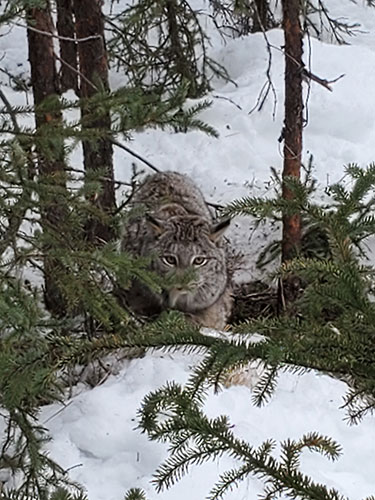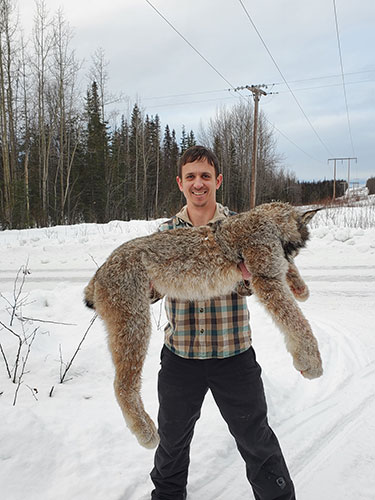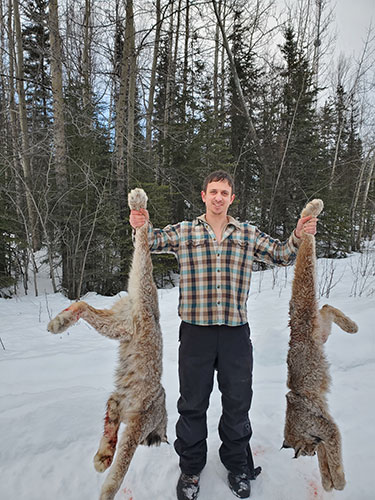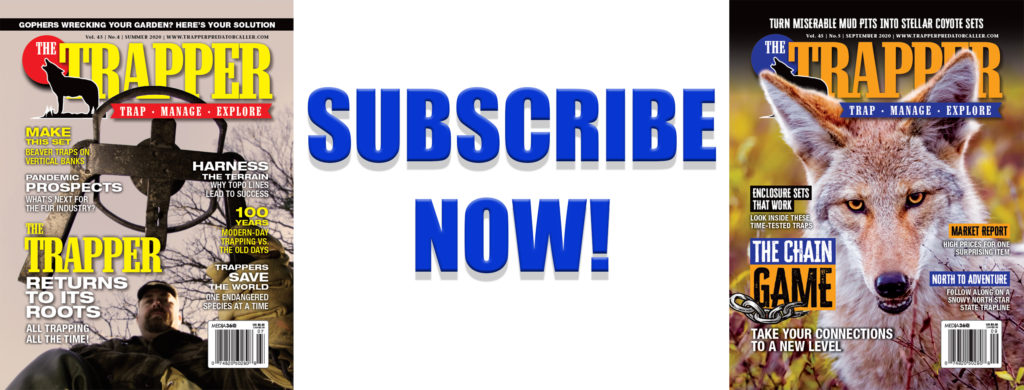By Lucas Byker
The author walks us through six key takeaways from his Alaskan lynx trapline, that most any trapper can employ — no matter the furbearer or location.
My snowshoe trail from a week prior was lightly coated in a half-inch of fresh, powdery snow. A lone set of Canada lynx tracks, about the size of a baseball, followed the depressions that my snowshoes created in the deep powder. As I approached my first set of hidden snares, my anticipation rose as the tracks never deviated from the trail. As my son and I crested the edge of the bluff heading down to a river bottom, we were greeted by the huge yellow eyes of our first Canada lynx, held securely in a snare placed in a pinch point along my snowshoe trail.

This photo shows a typical swamp on the author’s trapline; open wetland surrounded by dense black spruce. Photo credit: Lucas Byker
The areas that I trap in Southcentral Alaska are fur-rich; my focus has primarily been on river otters, beavers and coyotes, and I have had limited success with wolves. Where I trap in low, river bottom and swamp country, wolverines are rare visitors, but catching one is always a tantalizing possibility. From the start of my trapping career seven years ago up until last season, I have always been entranced by the massive Canada lynx tracks that occasionally padded their way through my line. Up until last season, they were strictly off-limits.
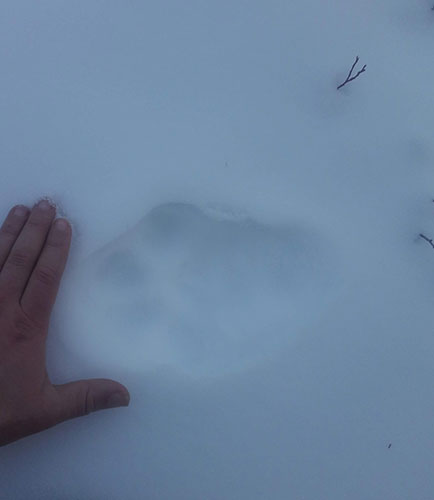
Look how large this tom lynx track is in the fresh powder snow. The enormous snowshoe feet on these cats prevents them from post-holing, even in loose powder. Photo credit: Lucas Byker
The game units that I focus most of my trapping efforts in employ a unique lynx harvest strategy not utilized elsewhere in southcentral Alaska. Lynx trapping is closed for approximately seven years, opened for three, then closed again for seven. This cyclical season opening and closing is intended to take advantage of a well-documented phenomenon, because lynx populations boom and bust in relation with the decadal rise and fall of snowshoe hare populations. January 1, 2021, marked the first lynx trapping opener during my trapping career, so my anticipation was palpable for the first opportunity to chase these majestic cats.
I was fortunate enough to harvest five beautiful lynx in four line checks. While I was pleased with my success, I also recognized that as a novice cat trapper, I made some obvious mistakes and wasted time with methods that simply didn’t produce. After looking back on the season, I discovered the following six key takeaways, which I plan to employ this winter.
1. Focus on Transitions
After already trapping wolves and coyotes in the same area as my lynx trapline, I knew that the areas with the largest concentrations of snowshoe hares were generally burned-over locations with regenerating vegetation. I had witnessed lynx tracks intermingled with the hare tracks in those areas, so I assumed they were good places to start.

This map depicts transition zones in typical lynx habitat. Blue indicates the transition between mature timber and a clear-cut, green indicates forest fire burn regrowth to clear-cut interface, and red indicates the transition between mature timber and burn regrowth. Photo credit: Lucas Byker
While I did find plenty of hares and some lynx tracks in the areas, the cats were very difficult to pattern, and didn’t travel through the birch and poplar re-growth jungles with any discernible consistency. Additionally, likely due to the abundance of live prey, the cats seemed oblivious to scent and visual attractors, and even shunned bait piles of grouse and ptarmigan scraps.
I noticed during a couple of different trap checks that along a transition area between dense black spruce habitat, there were consistent lynx tracks that weaved in and out of the timber, always staying close to the more open burned area. As my season was winding down, I scouted a few other transition areas, and found the same thing. While transitions from mature spruce to burned areas seemed to be the most popular, any transition between two habitat types seemed to attract cats.
While looking at the aerial imagery after the season, I realized that the locations where I either had success or near-success were not in large blocks of monoculture habitat. Instead, they were in areas where there were one or more transitions between diverse habitat types.
2. Don’t Be Afraid of Blocking
My 2020 season finished with a six-week long duel with a pack of wolves. Even though I was successful in harvesting my first wolf, chasing the smartest quarry out there made me paranoid and skittish to make any set that looked even remotely unnatural.
On one of my first lynx line checks, a friend joined me to get some time in the outdoors during our long Alaskan winter. I grew frustrated as we followed a single set of cat tracks that dodged, ducked and even stepped through three consecutive snares. With an hour of trapline time under his belt, my friend pointed out, “Why don’t you just put a bunch of spruce boughs around the snares so they have to walk through them?”
This seems like an obvious solution now, but at the time, my “wolf trapper’s brain” wouldn’t allow me to see that I wasn’t dealing with an exceptionally wary predator, and I could adjust my tactics accordingly. Once I started aggressively blocking down each snare set with spruce boughs, dead logs and brush, I stopped missing and started stacking fur.
Additionally, my stubborn canine trapping mindset resulted in snare misses where the cats stepped through the snare loop and continued on their way unscathed. Once I tightened down the snares and fine-tuned the proper height, I stopped missing and hip-snaring lynx and started picking up lethal catches.
3. Make It Easy for Them
I had known from previous years on the line that lynx like to follow my snowshoe and snowmachine trails through deep snow. Snares or traps set in my trails would surely be effective at catching them. I utilized this tactic heavily during my first lynx season, but I had some additional revelations based on my observations in the field.

A section of snowmachine trail on the author’s trapline covered in lynx tracks. This shows a typical transition between two habitat types — mature black spruce forest on the left, with sparse, stunted black spruce on the right. Photo credit: Lucas Byker
Setting in your own trail can work anywhere, but it is an absolutely deadly technique where the snow is deep. In one area, I walked through a section of timber bordering a large swamp, where the wind pushed drifts almost waist-deep. This area looked like marginal habitat, and so I quickly passed through it to make sets in a more promising location. However, toward the end of the season, I noticed that every lynx that traveled through that section of timber used my snowshoe trail, without failure.
For the coming season, I have added areas in my GPS where the topography and vegetation will pile snow into deep drifts, and I’ll be making trail sets in those locations. Even if the area is marginal habitat, it seems as though the deep snow allows you to create a lethal tunnel that no traveling cat can resist.
4. Funnels
One particular area on my trapline has a narrow band of black spruce that bisects two open swamps. The band of trees also traverses a small spur, which acts as a ramp to allow animals to climb a gentle grade from a river bottom to a higher bench. The wolves on my trapline occasionally use this spur to climb out of the river bottom onto the higher bench, so I had always placed a few wolf snares at this location. Moose and the occasional band of caribou would use the gentle grade of the spur to climb out of the river bottom, as well. While checking wolf snares the previous season, I noticed that cats would pass through the area, too. So once lynx trapping opened in 2021, I placed a half-dozen blind snares in this area. Those half-dozen snares accounted for three of my five successful catches.
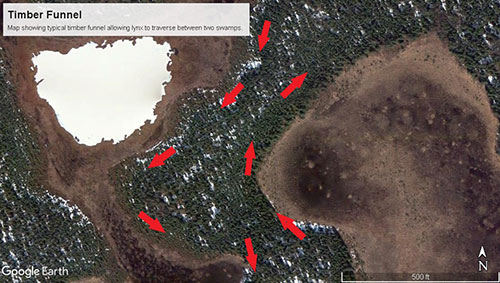
This map shows a funnel of timber between two swamps. The arrows indicate where most of the lynx travel occurs in these funnels; where the traveling cats can see into the swamps but still enjoy the relative safety of the timber. Photo credit: Lucas Byker
The attraction of this location for lynx was twofold. The cats used the gentle grade of the spur the same way the moose and wolves did, but the lynx also seem to be extremely reluctant to cross open swamps. My theory is that they are vulnerable to predation from coyotes and wolves due to the lack of climbable trees. So the thin strip of timber that lined the spur served as their only means of travel from one section of timber to another without exposing themselves.
Some additional post-season scouting of other timber funnels on my trapline revealed similar findings. Consistent cat sign could be found in most of the funnels, where lynx travel to avoid walking through open areas.
5. Don’t Overlook Intersections
My trapline is traversed by a central trail that is heavily utilized by dog mushers. Due to the dog traffic, I keep my sets a good distance away from this trail, but there are many less-utilized offshoot trails. Preseason scouting showed that where an offshoot trail met the main trail, lynx tracks and droppings were consistently present. Once such intersection was frequented by a female with two kittens, as well as what appeared to be two large, lone lynx.
I placed a large cubby with a concealed duck carcass, gland lure and hanging CD at one such intersection. On my first check, a large lynx had approached the cubby but hadn’t committed to the set. Disappointed, I added two satellite snares in nearby pinch points.
During the second check, fresh lynx tracks at the intersection again led straight to the cubby. The cat stopped short of the set, then walked around the cubby to get a better look from behind it. My satellite snare to the rear of the cubby looked undisturbed at first glance, but a closer inspection revealed two large yellow eyes and tufted ears poking up from behind a fallen log. While the cubbies were effective in drawing in the lynx, the satellite snares in nearby pinch points were almost always the snares that made the catches. This lynx ended up being my largest of the season, and on the stretcher it taped out longer than 40 inches from nose to tail.
6. Attractors Really Do Work
I learned from experienced lynx trappers and from reading articles about bobcat trapping in the Lower 48 that hanging visual attractors near sets is an effective tool for luring in cats. However, as a canine trapper, I was skeptical that hanging something shiny from a tree would actually fool a lynx into a snare.

Here’s a typical lynx cubby, constructed of a circular wall of spruce boughs, a visual attractor on a string and a duck carcass covered by a spruce bough. Bobcat gland lure was placed at the back of the cubby. Photo credit: Lucas Byker
One night, some mechanical trouble during the drive down forced me to run my trapline entirely in the dark. As I rode my snow machine down the line, illuminated by a stunning green display of the aurora borealis, a lone set of fresh lynx tracks jogged down the centerline of the trail. Up ahead, I had placed a lynx cubby set about 20 yards off the trail, adorned with a CD on a string and two satellite snares in nearby pinch points. As I approached the set, the tracks stopped at the exact spot where my snowshoe tracks led to the cubby set. The fresh snow told the story — the cat made a 90-degree turn, quickly walked the 20 yards to the hanging CD and was promptly snared.
In multiple other locations, fresh tracks in the snow showed me that traveling lynx rarely disregarded a visual attractor. At the very least, most of the cats on my line deviated briefly to examine the CD, reflective tape or tinsel I had hung. While this was the only cat I caught directly under a visual attractor, they are still a great tool to coax a lynx into an area where it can be snared.
Conclusions
While I will be utilizing all of the lessons listed above this coming lynx season, I also gleaned a few key takeaways that all trappers can employ, no matter what species they are pursuing, and no matter the region.

The author’s son with a young lynx, snared on the first trapline check of 2021. He biked most of the trapline that day on his new fat-tire bike (a Christmas present). Photo credit: Lucas Byker
Even if you have been very successful with other species, I think it is important to recognize that when pursuing a new species you need to stay flexible. In my case, what would have been laughable techniques for wolves or coyotes were extremely effective for lynx. If you stick too hard and fast to past lessons learned, you can miss what the animals are showing you in the present.
Having a new set of eyes on the trapline can give insights that can prove extremely valuable. My friend who accompanied me on the line this year had never before set foot on a trapline, but he also didn’t have any of my ingrained bad habits or biases. He was able to quickly point out that creating a wall of blocking would help guide the cats into my snares. That single change probably doubled my catch rate.

The author’s wife enjoying lynx kabobs. Lynx carne asada, sweet and sour cat, and breaded cat nuggets have all proven to be reliable options for preparing lynx meat. Photo credit: Lucas Byker
With all of these lessons under my belt and a rising lynx population, I expect to have another successful season, with full stretchers and a sizable fur check next spring.
